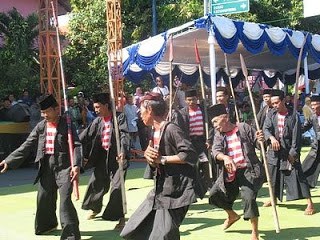Indonesia is a big archipelago, consists of more than 17.000 islands. With that many islands, Indonesia consists of more than 1000 tribes. Some tribes are bigger than the other, and some tribes are considered as sub-tribes of the bigger tribes. Each of these tribes has their own uniqueness and cultures, which contribute to Indonesia’s rich cultures. Before Youth Pledge at 28 October 1928, some tribes considered themselves as individual countries. However, after Youth Pledge, most tribes united and called themselves “Indonesians”. After Independence, more tribes united into Indonesia, and forming what we know as Indonesia now.
See also: Indonesia Military Power – Indonesian Red Cross Society
History
There are many opinions about where Indonesian people’s ancestors came from. Historians spoke out their arguments of justification from their own suppositions. Although there are so many opinions, there is one opinion that has strong evidence. The opinion came from a Dutch historian, Von Heine Geldern.
See also:
A. Massive Migration to Austronesia
According to his researches, Von Heine Geldern argued that Indonesian people’s ancestors came from Central Asia. He explained that since 2000 BC until 500 BC (from Neolithicum era to Bronze era) there had been migration of ancient people from Yunan (southern China) to places in southern Asia, including Indonesian Archipelago. This massive migration probably happened because of massive natural disasters or wars among tribes.
The archipelagos in southern Asia was named Austronesia by Geldern, which means “southern archipelago” (Austro = south, Nesos = island/archipelago). Austronesia itself consists of massive area, including islands in Madagascar (southern side) to Easter Island (eastern side), and from Taiwan (northern side) to New Zealand (southern side). Geldern’s opinion was based on discovery of antient tools of prehistoric people in the form of square stone pickaxes in western side of Indonesia (including Sumatera, Java, Kalimantan and Sulawesi). These pickaxes are exactly the same like ancient tools in other Asian regions like Myanmar, Vietnam, Malaysia, and Cambodia, especially around Yunan.
Von Heine Geldern’s opinion was also supported by Dr.H.Kern studies in 1899, which discussed about 133 folk languages in Indonesia. From the studies, Dr.H.Kern concluded that all the folk languages were rooted from one family of languages, the Austronesia language. Migration of prehistoric people from Yunan happened at least 3 times. Those people brought Neolithicum and Bronze civilization with them, such as bronze shoe-shaped axes and bronze potteries from Dong Son plain.
B. Crossing the Sea with Outrigger Boats
From historical evidences, it is found out that Indonesian ancestors crossed the sea from mainland South-east Asia by outrigger boats. They used those small boats to reach Indonesia and other Austronesia islands. They were sailing in groups without any fear of storms and big waves in the oceans. This proved that Indonesian ancestors are brave people. With the journeys full of obstacles, they finally reached some islands in Indonesia. They were named Malay-Indonesian people.
C. Distribution of Malay – Indonesian people
The name of Malay – Indonesian for Austronesia people generally was applied to everyone who lived in Nusantara (now Indonesia). However, according to their arrival time, and the places they first lived in, the Malay – Indonesian people can be divided into 3 groups: the proto-malayan, deutero-malayan, and primitive people.
[accordion]
[toggle title=”1. Proto-malayan Group (Old-Malayan)” state=”closed”]
Proto-Malayan or Old-malayan is one of Indonesian people’s ancestors. They are the first Austronesian people who arrived in Indonesia in the first “wave” (around 1500 BC). The proto-malayan people came into Indonesia in 2 routes: first, the west route from Malaysia and Sumatera; and the second is north or east route from The Phillipines and Sulawesi.
This Proto-malayan group is considered to be more developed than other prehistoric people in that time. This is proven by the foundings of neolithicum civilization with them, which consists of smooth stone tools. The most famous tools are square stone axes, which were found in western side of Indonesia, including Sumatera, Java, Kalimantan, Bali, and North Sulawesi. Their direct descendants now are Batak, Dayak and Toraja people.
[/toggle]
[toggle title=”2. Deutero-malayan Group (New-malayan)”]
Deutero-malayan people are the Austronesian people who came to Nusantara in the second “wave”, around 400-300 BC. Deuter-malayan people succeed to do assimilation with their predecessors, the Proto-malayan. Based on historical evidences, Deutero-malayan came into Nusantara from west route; they came from Yunan (Tonkin Bay), Vietnam, Malaysia, and finally they settled in Nusantara.
Deutero-malayan people already had more developed civilization than Proto-malayan people. They succeed in making tools from bronze and iron, some of it are shoe-shaped axes, cone axes, potteries, menhirs, dolmens, sarcophagus,stone tombs, and step pyramids. Indonesian tribes which are direct descendants of these people are Javan, Malay and Bugis tribes.
See also: Indonesia Flag
[/toggle]
[toggle title=”3. Primitive Group”]
Before Austronesian people came into Nusantara, there were already some prehistoric groups in these areas. They are primitive people with very simple civilization. They are Pleistocen people, Wedoid Tribes, and Negroid Tribes.
Pleistocen people: These people have nomad lifestyle. Their ability and civilization are limited, thus it is difficult to do research about them. Their nomad lifestyle and their simple hunting style were adapted by some Indonesian tribes though.
Wedoid Tribe: The remainings of Wedoid tribes still can be found these day. They do foraging and food gathering from the forest. They also have very simple civilization. Today, the direct descendants of Wedoid Tribe is Sakai Tribe in Siak and Kubu Tribe in the border of Palembang and Jambi provinces, Indonesia.
Negroid Tribe: There is no remaining of Negroid Tribe in Indonesia. But they are still exist in hinterlands of Malaysia and The Phillipines. Their direct descendants are Semang Tribe in Malay Peninsula and Negrito Tribe in The Phillipines.
[/toggle]
[/accordion]
Tribes in Indonesia
Actually, there are hundreds of major tribes in Indonesia, but in this article I will only explain 31 tribes that represent 34 provinces of Indonesia. Each of these tribes has its own uniqueness and creativity which are characterized by different style of cultures.
1. Aceh Tribes
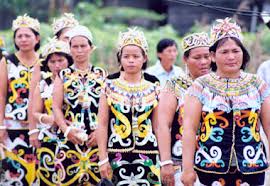 Aceh Tribe is one of the oldest tribe in Indonesia. They are from Nanggroe Aceh Darussalam province. Their major religion is Islam, and the dialect is Aceh dialect. Aceh dialect came from west Malay-Polinesia language, which still in the same family as Champa language that is spoken in Vietnam and Cambodia.
Aceh Tribe is one of the oldest tribe in Indonesia. They are from Nanggroe Aceh Darussalam province. Their major religion is Islam, and the dialect is Aceh dialect. Aceh dialect came from west Malay-Polinesia language, which still in the same family as Champa language that is spoken in Vietnam and Cambodia.
Nanggroe Aceh Darussalam is the most west side of Indonesia, and in middle century it was one of the most important port around Malay Strait. There are many foreign people and traders staying in the port, for example Arabians, Chinese, Thai, Champas, and Malay.
Then, some of these traders would later choose to marry local women and live around the coast line. That is why Aceh Tribe is descendant of those races.
See also: Saman Dance – Largest Mosque in Indonesia
2. Minangkabau Tribes
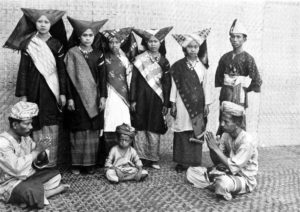 Minangkabau Tribe is from West Sumatra Province. Sometimes this tribe is just called “Minang”. So, if we hear somebody says “He is a Minang”, it means he is from Minangkabau Tribe. Minangkabau Tribe mostly embrace Islam religion, and Islam became the base of their cultures, for example Randai dance. Their dialect is Minang dialect, which has the similarity with Malay dialect.
Minangkabau Tribe is from West Sumatra Province. Sometimes this tribe is just called “Minang”. So, if we hear somebody says “He is a Minang”, it means he is from Minangkabau Tribe. Minangkabau Tribe mostly embrace Islam religion, and Islam became the base of their cultures, for example Randai dance. Their dialect is Minang dialect, which has the similarity with Malay dialect.
Minangkabau Tribe has matriarchal culture, which means that the house would later belong to the daughters of the family, and the woman pays the dowry to the man’s family in wedding.
The boys, after reaching 12-13 years old, start to live in mosques or Islamic boarding school, while the girls stay with their family. After reaching early adult age, the boys would go out of their hometown for finding job, experience, and knowledges, which later would be very useful when they start a family. Therefore, some Minang people live outside of West Sumatra Province, even abroad.
The first president of Singapore, Yusof bin Ishak, is a Minang descent. Singapore’s national anthem, Majulah Singapura, was composed by Zubir Said who was born in Minangkabau.
See also: Indonesian National Flower – Indonesian Heroes
3. Batak Tribes
 Batak Tribe is from North Sumatera. This is one of the biggest tribes in Indonesial, because it has many sub-tribes: Batak Karo, Batak Toba, Batak Simalungun, Batak Pakpak, Batak Angkola, and Batak Mandailing.
Batak Tribe is from North Sumatera. This is one of the biggest tribes in Indonesial, because it has many sub-tribes: Batak Karo, Batak Toba, Batak Simalungun, Batak Pakpak, Batak Angkola, and Batak Mandailing.
Batak arts are also already recognized worldwide, for example Serampang Dua Belas dance, Tor-tor dance, Batak accoustic musics, and its traditional house. Those dances and musics are often performed abroad. If you want to know more about Batak Tribe, you can visit Lake Toba (the biggest caldera in the world) in North Sumatra.
Batak tribe also has their own traditional clothes, the Ulos. Ulos can be very expensive, depends on the material and golden threads woven in the cloth. Ulos is worn in all traditional ceremonies, such as marriage, building new house, funerals, submission of heritage, welcoming guests, and annual feasts.
4. Betawi Tribes
 Every Indonesian people know that Betawi Tribe comes from DKI Jakarta Province. This tribe never leaves their art of massive dolls, which are called “ondel-ondel”.
Every Indonesian people know that Betawi Tribe comes from DKI Jakarta Province. This tribe never leaves their art of massive dolls, which are called “ondel-ondel”.
A historian, Sagiman MD, said that Betawi Tribe has been exist since Neolithicum period, while the indigenous Betawi people came from Java Island: Javan, Sunda and Madura people.
Betawi arts are often aired in local Indonesia television, such as lenong and traditional dances since it represent the art of Indonesia’s capital city. Some sitcoms also have stories about the life of Betawi people.
See also: Largest Cities in Indonesia – History of Jakarta
5. Baduy Tribes
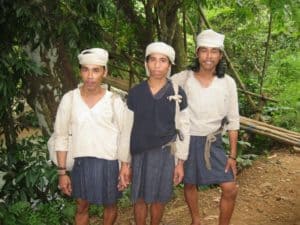 Baduy Tribe lives in Banten Province. They were Pajajaran citizens who fled into the hinterland of Banten when Sunda Kelapa port was overcome by Demak kingdom.
Baduy Tribe lives in Banten Province. They were Pajajaran citizens who fled into the hinterland of Banten when Sunda Kelapa port was overcome by Demak kingdom.
Then, until now, Baduy Tribe has very simple lifestyle. They are against any modernization. They live without electricity, cars, or anything from modernization.
They speak Baduy dialect, which is rooted from Sundanese language. Actually, Baduy Tribe consists of 2 sub-tribe: Baduy Dalam (Inner Baduy) and Baduy Luar (Outer Baduy).
See also: Indonesian Tea
Baduy Dalam still practise their ancient cultures, for example refusing to know about other life outside of their area, refusing to be photographed, and refusing to use modern tools in their daily life. Baduy Luar is less strict, where the tribe lets its people to use more modern tools like radio, TV and handphones.
They also have weaving art which are taught from generation to generation. Baduy Tribe likes conserving nature. They refuse to destroy trees. They even feel guilty if they find the forest around them is destroyed. They really believe that taking care of trees will guarantee the welfare of nature.
See also: Deforestation in Indonesia – The Biggest Stadium in Indonesia
6. Sundanese Tribes
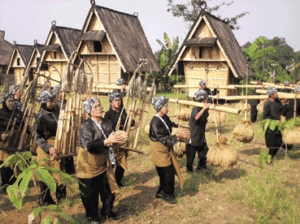 All Indonesian people know that Sundanese Tribe comes from West Java Province. This tribe is known for their gentle manners, optimistic, friendly, and cheerful. They speak Sundanese language. Sundanese girls are nominated as one of the most beautiful girls in Indonesia. They conserve their traditional music, Angklung, which is now taught in most elementary schools in Bandung, the capital of West Java.
All Indonesian people know that Sundanese Tribe comes from West Java Province. This tribe is known for their gentle manners, optimistic, friendly, and cheerful. They speak Sundanese language. Sundanese girls are nominated as one of the most beautiful girls in Indonesia. They conserve their traditional music, Angklung, which is now taught in most elementary schools in Bandung, the capital of West Java.
On the other hand, they are also known for their healthy foods, such as pepes (steamed fish, chicken or tofu wrapped in banana leaves) and raw vegetables salads.
See also: Indonesian Politics – Most Expensive Universities in Indonesia
7. Madura Tribes
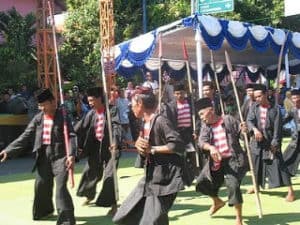 Madura Tribe comes from Madura island, on North-east side of East Java Province. This is one of the biggest tribes in Indonesia, since many of Madura people transmigrated onto other islands in Indonesia. Basically, they are hard-workers and persistent.
Madura Tribe comes from Madura island, on North-east side of East Java Province. This is one of the biggest tribes in Indonesia, since many of Madura people transmigrated onto other islands in Indonesia. Basically, they are hard-workers and persistent.
One of the famous cultures of Madura Tribe is Karapan Sapi, a traditional bull race which is held during dry season every year. The sport car Lamborghini Hybrid is inspired by Karapan Sapi race.
See also:
8. Dayak Tribes
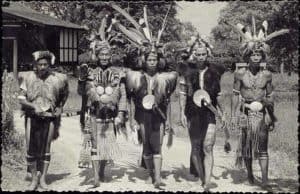 Dayak tribe comes from Kalimantan Island. It is one of the biggest Indonesian tribes, having more than 400 sub-tribes. Literally, “Dayak” means people who live in upstream areas.
Dayak tribe comes from Kalimantan Island. It is one of the biggest Indonesian tribes, having more than 400 sub-tribes. Literally, “Dayak” means people who live in upstream areas.
They have many extreme cultures, which make them respected throughout Indonesia and other countries. The most famous extreme cultures of Dayak Tribe is tattoo.
Moreover, The vocalist of Red Hot Chilli Peppers (Anthony Kiedis) ever came to Kalimantan to get tattooed by Dayak people, and he is very proud of the tattoo.
Dayak people believe that if a Dayak person who has black tattoo pass away, the tattoo color would turn into golden color, and the corpse would glow. Until now, Dayak Tribe is also known for their witchcrafts.
See also:
9. Bugis Tribes
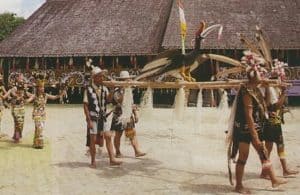 Bugis Tribe comes from South Sulawesi. They have interesting uniqueness, for example the traditional house, which is built on stilts and can be demolished and moved to another location.
Bugis Tribe comes from South Sulawesi. They have interesting uniqueness, for example the traditional house, which is built on stilts and can be demolished and moved to another location.
It is a tradition that whenever a family wants to move to new place, people in the village help move the traditional house to the new place. Only in this tribe, you can find that people bring their house together when they move away. But now this tradition is difficult to find, since Bugis people now prefer to live in permanent and modern houses.
Bugis people also belive in myth which says that smiling in early morning can increase a woman’s beauty.
See also: Endangered Animals in Indonesia – National Library of Indonesia
Others
There are several tribes that existed in Indonesia beside that has been explained above, such as:
10. Akit Tribes
Akit Tribe is one of the oldest tribes in Indonesia. The tribe is from Riau Province. There are many other tribes in Riau province, such as Talang Mamak Tribe, Malay Tribe, Laut Tribe, Bunoi Tribe, and Sakai Tribe; but Akit Tribe is the oldest one in Riau, the tribe was already exist far before other tribes came and settled in Riau.
Moreover, until now, Akit Tribe still has simple lifestyle. They forage and gather foods in the forest, just like their prehistoric ancestors.
See also: Best Airports in Indonesia – Indonesian Landmarks
11.Sakai Tribes
Sakai Tribe is also from Riau, but they live in hinterland. The data and social map of Indonesia showed that most of Sakai people live in isolated areas and far away from modernization. They also lack access of education.
Although they live in isolated areas, Sakai people always preserve their cultures. We can see that through the unique traditional houses of Sakai people. They never want to stay in other type of house, even the modern ones.
Now, an area in Riau which is full of Sakai traditional houses is made into touristic place. Many foureign tourists coming there to see Sakai cultures.
12. Kerinci Tribes
Kerinci Tribe lives in Jambi Province. When we hear about Kerinci, we usually think about the highest volcano of South-east Asia, not the tribe. Since thousands years ago, there is a tribe who lives in the Bukit Barisan highland, around Mount Kerinci. Therefore, this tribe is named Kerinci Tribe. They have their own dialect, but still in the same family of Austronesian language. They mainly do agricultures.
We can see the cultures of this tribe if we do hiking on Mount Kerinci, or when we visit Lake Kaco, a caldera on Kerinci Mountain.
See also: Volcanoes in Indonesia – Indonesian Etiquette
13. Musi Tribes
Musi Tribe is also known as Sekayu Tribe. They live in South Sumatera, near Palembang. Musi people originally live around the sides of Musi river, but now we can find them dispersing around Indonesia because of works and educations. Their dialect is Musi dialect, which is actually a Malay dialect but they replace “a” at the end of word with “e” (like in “get”). They live by doing agricultures, fishing, trading, and working in companies.
See also: Sumatran Tigers – Indonesian National Flower
14. Lampung Tribes
Lampung Tribe is the of a tribe which has the same name with their place to live, Lampung Province. They are known to have rich cultures, and they are friendly. They mix well with Javanese transmigrants. They speak Lampung dialect, which is rooted from Malay language. The most known cultures of Lampung Tribe is tradition of eating together called “Seruit”. This tradition is usually done in big celebrations, like Eidh al Fitri, Wedding, and other traditional ceremony.
Then, Seruit is done by sitting together on a carpet face-to-face, with foods in the middle. The menu is various, from grilled fish, cooked and raw vegetables, and sambal (Indonesian and Malay chilli sauce). The foods are placed on layers of banana leaves and eaten directly by hands. This symbolizes the harmony and kinship of Lampung people.
See also: Luwak Coffee – Indonesian Landmarks
15. Serawai Tribes
Serawai is a tribe who lives in Bengkulu Province. The word Serawai is derived from “Satu Rawai”, means “one family”. Serawai people are known for their high mobility and hard-working. They often leave their hometown to seek new and better life. They speak Malay language.
In Bengkulu, Serawai people live by doing farming and agricultures. They plant various agricultural plants, like coffee, cloves, para rubber tree, crops, and horticultures.
16. Samin Tribes
Samin Tribe lives in Central Java Province. They still embrace their ancestor’s cult, Samin Surosentiko. This cult taught “sedulur sikep”, fighting without violence when they were asked to pay tax by the Dutch.
In colonial time, Samin Tribe really hated the Dutch because the Dutch asked them to pay tax or land-rent. They think that lands are public properties, so they do not need to pay tax.
Samin people are dispersed throughout Central Java, but most of them live in Blora, 127 km on east side of Semarang.
17. Javan Tribes
This tribe originally came from Central Java, but now dispersed to East Java, Yogyakarta, and also throughout Indonesia by transmigration program. We also can find Javan Tribe in Suriname, South America, as a result of transmigration and agriculture programs by the Dutch. They speak Javanese language.
Javan Tribe are known for their gentle manners, which we can see in many of their performed arts. They are also known to be hard-workers. All of Indonesian presidents are from Javan Tribe.
See also: Indonesia Java – Unique Facts about Indonesia
18. Bali Tribes
Just like the name, this tribe comes from Bali Island. The majority of Balinese people still honor their ancestral teachings, such as using Balinese language, Balinese cultures, and Hinduism.
Balinese cultures are already famous over the world, and many foreign tourists come to Bali to witness the rich cultures. Balinese cultures are never far away from performance arts and sculptures. Balinese people are called artists, because they do various types of art activities (such as traditional dancers and sculptors) in their free time, regardless of their daily jobs, such as traders, teachers, farmers, drivers, etc.
See also: Hinduism in Bali
19. Sasak Tribes
Sasak Tribe comes from West Nusa Tenggara Province.
Their most unique tradition is “Kawin Culik”, which is a marriage rituals where the groom would kidnap the bride. But this tradition is done by mutual agreement through traditional institution, not just kidnapping any girl.
They also do Lebaran Ketupat or Lebaran Topat. This tradition is done by doing picnics to touristic places or priests’ tombs simultaneously. Then they sit together on a carpet or blanket, and eat ketupat (a rice cake wrapped in weaved coconut leaves) brought from each home. This tradition show the harmony andkinship of sasak people.
See also: Indonesian cultures – Bali Facts
20. Bima Tribes
Bima Tribe comes from East Nusa Tenggara Province. They still conserve their ancestors’ lifestyle, by doing nomad agricultures. They cultivate dry fields from one mountain to another. They also do nomad life, following each field they take care of. The nomad lifestyle makes them follow simple life, without electricity and education.
21. Banjar Tribes
Banjar Tribe comes from Banjar, South Kalimantan Province. Traditionally, Banjar people have views of life based on the believes of adages and symbols, but now most of them embrace Islam religion. They speak Banjar language, which is rooted from Malay language.
See also: Indonesia Religion – Indonesian Language
22. Kutai Tribes
Kutai Tribe or Urang Kutai comes from East Kalimantan Province. Although Kutai was the oldest Hindu Kingdom in Indonesia, now most Kutai people embrace Islam religion and live on the sides of rivers.
Kutai Tribe has the oldest cultural feast in Indonesia, the Erau Kutai Kertanegara Cultural Festival which has been held since 13th Century AD until now. They always try to conserve their ancestral values and cultures.
See also: Indonesia Orangutan
23. Minahasa Tribes
Minahasa Tribe comes from North Sulawesi Province. It is believed that Minahasa Tribe came from a massive stone which now becomes a cultural site. The stone is called “Watu Pinawetengan”. Watu means Stone, and Pinawetengan means Distribution Place. According to old people of Minahasa, Watu Pinawetengan also means the tribe’s ancestral promise.
Minahasa people speak Minahasa language. The traditions of Minahasa Tribe which are still held until now is Maengket Dance and Kasabaran Dance.
See also: Indonesian Coral Reef – History of Jakarta
24. Toraja Tribes
Toraja Tribe comes from South Sulawesi Province. This tribe is known to have many cultures which are considered unique and creepy.
One of the most famous traditions is funeral rituals which is very expensive. The richer the family is, the bigger the funeral ceremony is. This ceremony costs lots of money because there will be rituals of slaughtering buffaloes and pigs; while the most expensive buffaloes in the world come from Toraja.
The other tradition is Ma’nene, which is an annual tradition of changing clothes of their ancestors’ corpses. Every year, the families would change clothes of their ancestors’ corpses, with the brand new clothes. This is considered creepy by some people, because most of the time, those corpses are already rotten.
Other than Toraja Tribe, South Sulawesi is also home for other tribes, such as Mandar Tribe, Sa’dan Tribe, Makassar Tribe, and Bugis Tribe.
See also: Indonesian Martial Arts – Indonesian Theater
25. Mori Tribes
Mori Tribe comes from Central Sulawesi Province, in Morowali region. From that region, overtime, Mori Tribe dispersed to other city and regions in Central Sulawesi. Most of Mori people embrace Protestanism. They consider Protestanism as their folk religion, and even base their daily life according to Protestanism.
26. Buton Tribes
Buton Tribe lives in South-east Sulawesi Province. They have a unique tradition that attracts both domestic and foreign tourists, the Pekande-kandea tradition.
Pekande-kandea means eating out in Buton language. The tradition is done by feeding governments or guests by Buton girls. We can say that this tradition is a way to welcome guests. In ancient time, Pekande-kandea is a tradition to welcome paramilitary troops of Buton Sultanate from war.
See also: Indonesian Heroes
27. Gorontalo Tribes
Gorontalo Tribe is from Gorontalo Province, which is the neighbor of North Sulawesi Province.
Gorontalo people believe that Gorontalo derived from the word “Hulontalo”, which means wanderers who came from the sky. Before settling in Gorontalo province, their ancestors were known as nomads who moved from an area to another to find fertile soil. They speak Gorontalo language.
28. Buru Tribes
Buru Tribe is from Maluku. They were actually a community who lived on Buru Island, one of big islands in Maluku Archipelago. Buru people call themselves “gebfuka”, which means “land/earth people”, and they speak Buru language.
Now Buru people are already dispersed throughout Maluku archipelago.
See also: Indonesian Education System – Most Beautiful Fabric in Indonesia
29. Togutil Tribes
Togutil Tribe comes from North Maluku Province. They are also known as Tobelo Dalam (Inner Tobelo) Tribe. They live in groups and they still depend on forests, doing food gathering and hunting. They have nomad lifestyle, and we can see it from their traditional houses which are built of woods and bamboos, with roofs made of palm leaves. They speak Tobelo language.
However, these people do not like to be called Togutil, because Togutil in Tobelo language has conotative meaning of “retarded”.
See also: Poverty in Indonesia – Indonesian people
30. Dani Tribes
Dani Tribe lives in West Papua Province. Both domestic and foreign tourists already know that Dani Tribe has rich cultures and tradition. For example, the unique Honai houses, War Dance which is performed to honor their ancestors, and the sacred stone burning ceremony to welcome guests.
Dani people are also willing to cut off their fingers as a form of deep love to their deceased spouse or family.
31. Asmat Tribes
Asmat Tribe lives in Papua Island. They are believed to be incarnation of Gods in Papua land. They are specialized in wood carving, and they have unique characters in their carvings.
Many researchers from Indonesia and other countries come to study the life of Asmat people. Those researchers proved that until now, Asmat Tribe still conserve their cultures and cult. Both Asmat and Dani people embrace Christianism, but people who live in hinterlands still practise animism.
See also: Indonesian National Flower – Indonesian Women Rights
Development of Indonesian Tribes
After the Youth Pledge in 28 October 1928, many tribes considered themselves as “Indonesians”, since they had the same vision and mission of being independent from colonialism, and they feel the kinship towards each other. This is also explained in a phrase “Bhinneka Tunggal Ika” found in Sutasoma book, written by Mpu Prapanca in 12th Century AD. “Bhinneka Tunggal Ika” means although we are different, we are in unity. This phrase is used as a national motto of Indonesia.
In ancient time, most of Indonesian tribes embrace their ancestral cults, which mainly based on animism and dinamism. The trading process, colonialism, marriages, and missionaries spreaded new religions: Hinduism, Buddhism, Islam, and Christianism. That is why we can find some tribes have their major religions.
See also: Indonesia Human Rights
Moreover, with transmigration process and education programs, the tribes now can be found in many islands and big cities of Indonesia, for example we can find Batak, Aceh, Toraja, Sundanese, Javan, and Bugis people in Jakarta, along with the native Betawi people. The cross-marriages between tribes are common too now (for example Batak man married to Javanese woman, or Bugis man married to Aceh woman), since some Indonesian tribes require young men to seek new life outside of their hometown, and young couples usually meet in universities or workplaces.
See also: Indonesia Military Power – Indonesian Red Cross Society
Indonesia has so many tribes, whose cultures attract both domestic and foreign tourists. These tribes also have wise cultural values. As Indonesians, we should not discriminate any tribes, because most of the tribes have life values which support kindness for human and nature.
